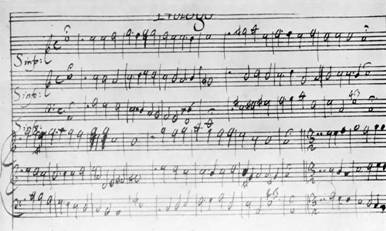Sanctus And Benedictus |
Andrea Gabrieli |
The Sanctus is an acclamation which follows the Sursum Corda and divides the Eucharistic preparation. It is the oldest part of the Ordinary of the Mass, evolving between the third and the fifth centuries. It forms a conclusion to the first part of the Eucharistic rites and, in the early years, until around the year 800, was sung by priest and people alike. The text has its origins in Isaiah (6:3) in the context of celestial praises of cherubim and seraphim. In the Eastern Orthodox church the Sanctus is adapted in the Greek as a Trisagion – a thrice holy petition (Holy God, Holy and Mighty, Holy and Immortal – have mercy upon us). As with the Kyrie, at the second council of Orange in 529, the words of the Sanctus were also prescribed for use at Vespers. Gabrieli’s setting of the text here is for three choirs, making a twelve-part chorus of SSAT/SATB/BrassTBB. The three choirs take turns to sing until the third line of text, when they all sing together. The same structure is adopted in the Benedictus with the choirs coming together on the word Osanna. |
|
Sanctus, sanctus, sanctus, |
Holy, holy, holy, |
Benedictus qui venit in nomine Domini. |
Blessed is he who comes in the
name of the Lord. |
Recercar Con Obligo Di Cantare La Quinta Parte Senza Toccarla |
Girolamo Frescobaldi |
This piece for keyboard, with cornett obbligato, was published in Venice in 1635 as part of Fiori Musicali, and is one of the most influential collections of keyboard music from this period. Fiori Musicali (Musical Flowers) is a collection of liturgical organ music by Frescobaldi. It contains three organ masses and two secular capriccios. Generally acknowledged as one of Frescobaldi's best works, Fiori Musicali influenced composers during at least the next two centuries. Johann Sebastian Bach was among its admirers, and parts of it were included in the celebrated Gradus ad Parnassum, a highly influential treatise on counterpoint published in 1725 by the music theorist Johann Joseph Fux (1660-1741). |
|
Jubilate Deo |
Giovanni Gabrieli |
This setting is for three choirs of five parts as follows: SSAT brass/AT,brass,B,brass/brass,SA,brass,B. The music is extravagant, both melodically and harmonically, and is a wonderful example of the Venetian chori spezzati style of the late sixteenth century. The choirs often sing antiphonally, imitating one another, and then, at certain moments, come together to present a very thick and exciting texture. The piece ends with a fast triple time section. |
|
| Jubilate Deo omnis terra. | O be Joyful in the Lord all ye lands. |
| Exultate justi in Domino. | Rejoice ye righteous in the Lord. |
| Et gloriamini omnes recti corde. | And shout, all ye of an upright heart. |
| Quoniam exaudivit Dominus deprecationem meam, | For the Lord has heard my prayer, |
| Dominus orationem meam suscepit, | The Lord has answered my prayer, |
| O fausta dies, O laeta dies. | O lucky day, O joyful day. |
| Haec dies quam fecit Dominus | This is the day which the Lord has made |
| Exultemus et laetemur in ea. | Let us rejoice and let us be glad in it. |
The translations of the psalms are those of Miles Coverdale from the Book of Common Prayer (1549).
Programme notes and commentary by Peter Parfitt.
An extract of manuscript by Claudio Monteverdi
